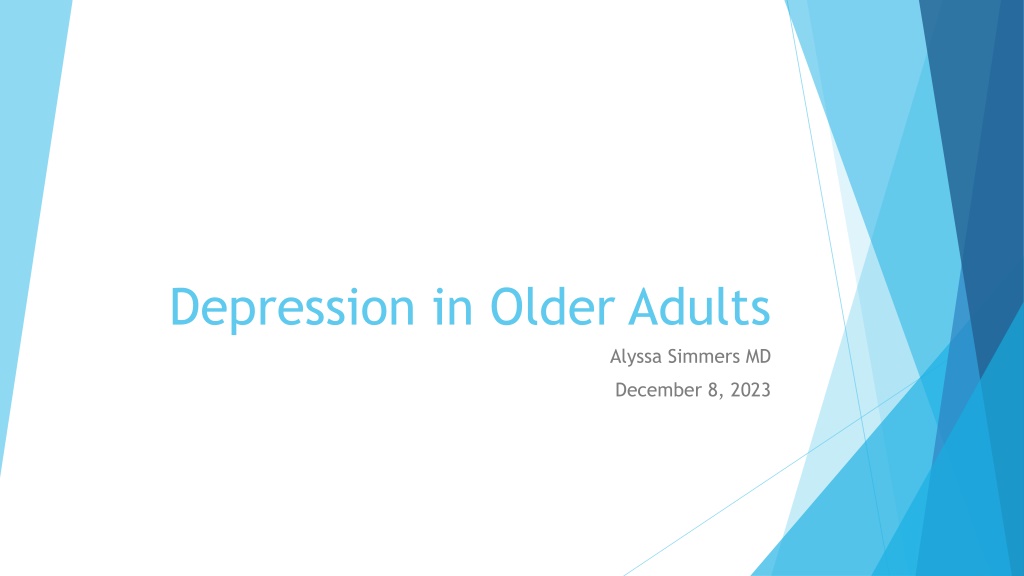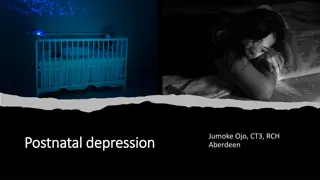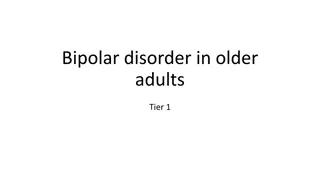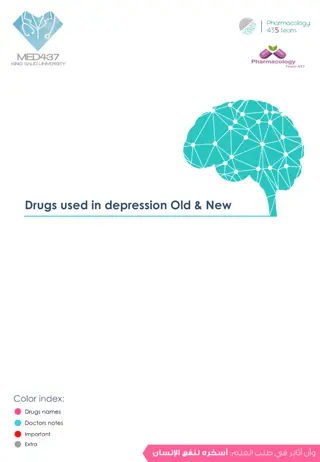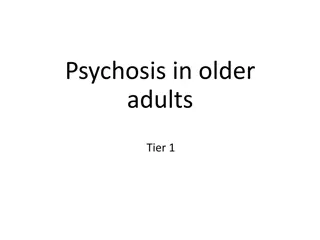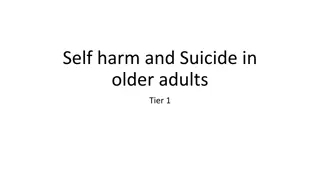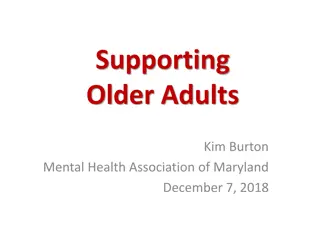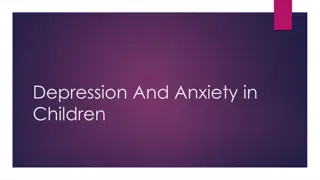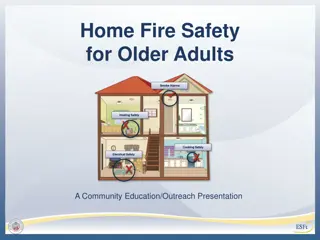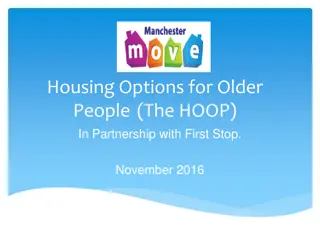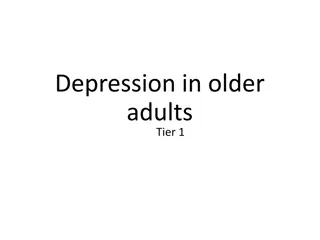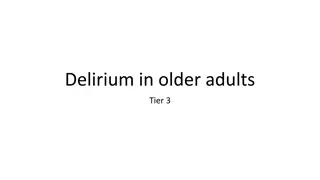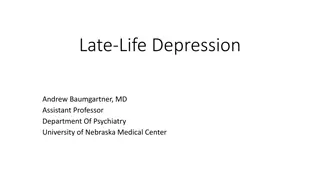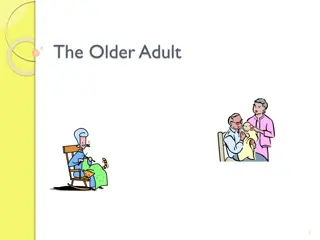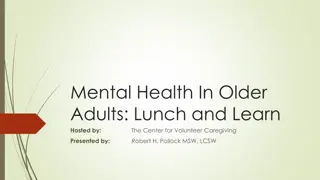Understanding Depression in Older Adults: Symptoms, Risk Factors, and Treatment Options
Depressive symptoms in older adults are common but often go unrecognized. While depression is not a normal part of aging, older adults may exhibit a variety of depressive symptoms. Risk factors include pain, isolation, insomnia, medical comorbidities, and more. Classification includes Major Depressive Disorder, Dysthymia, and Psychotic Depression. Diagnosis through screening tools like PHQ-2 and PHQ-9 is essential, along with treatments such as psychotherapy, cognitive-based therapy, and addressing medical conditions. It's important to recognize and address depression in older adults to improve their quality of life.
Download Presentation

Please find below an Image/Link to download the presentation.
The content on the website is provided AS IS for your information and personal use only. It may not be sold, licensed, or shared on other websites without obtaining consent from the author. Download presentation by click this link. If you encounter any issues during the download, it is possible that the publisher has removed the file from their server.
E N D
Presentation Transcript
Depression in Older Adults Alyssa Simmers MD December 8, 2023
Depressive symptoms are common and frequently unrecognized However, depression is NOT a normal consequence of aging Older adults are less likely to meet criteria for Major Depressive Disorder but can still have a variety of depressive symptoms Epidemiology Older adults less likely to recognize depression in themselves Increased rates of depression in long term care residents
Risk Factors Female Pain Isolation Insomnia Martial Status Functional Impairment Lower socioeconomic status Cognitive Impairment Medical Comorbidities
Classification Major Depressive Disorder same DSM V criteria as in younger adults Dysthymia depressive symptoms occurring on most days over at least 2 years Minor Depression Subsyndromal Depression depressive symptoms that do not meet criteria for Major Depression or Dysthymia Psychotic Depression Major Depressive Disorder with psychotic features such as delusions and hallucinations
Classification Vascular Depression Depression may develop in along with chronic ischemic changes in the brain. May develop along with cognitive and functional impairments Depression in Alzheimer s Disease Depression as a complication of Alzheimer s Disease
Diagnosis Screening: PHQ-2 Little interest or pleasure in doing things? Feeling down, depressed, or hopeless? PHQ-9 10 points or more: good sensitivity and specificity for Major Depressive Disorder Geriatric Depression Scale 15 yes or no questions Screen for suicide risk Screen for firearms in the home
Treatment Look at current medication list Meds like benzos and opiates could have depressive side effects Do any medical conditions need improved treatment? ie: Unrecognized/uncontrolled diabetes or thyroid disease Psychotherapy Cognitive Based Therapy Problem Solving Therapy Interpersonal Therapy Exercise!
Treatment: Pharmacotherapy 50% of patients recover with initial antidepressant therapy 1/3rdwill recover when antidepressant is switched or augmented with another antidepressant or therapy Give medication at least 4-6 weeks to start to show affect May take longer in geriatric population (up to 16 weeks!) If no response at all by 4 weeks, then less likely to have any improvement with additional time
Treatment: SSRIs Citalopram Start at 10 mg daily Max dose: 20 mg due to prolonged QTc risk Escitalopram Start at 10 mg Max dose 20 mg Sertraline Start at 25 mg Max dose 200 mg Helpful Tips: GI distress is common and usually transient side effect of SSRIs Paroxetine: avoided due to anticholinergic properties. On the BEERS list SSRIs (and SNRIs) can cause SIADH
Treatment: SNRIs Duloxetine Can be useful in patients with chronic pain Start: 20-30 mg once a day Max: 60 mg once a day Venlafaxine Can increase blood pressure Start: 37.5 -75 mg Max: 225 mg
Treatment: Atypical Antidepressants Mirtazapine Can cause drowsiness and weight gain (sometimes deemed desirable side effects) Can also cause dry mouth and constipation Start: 7.5 mg nightly Max: 45 mg nightly Lower doses more useful for sleep Bupropion Avoid if history of seizure Can elevate blood pressures Avoid in depressed patients with agitation Start: 75 mg BID or 150 mg daily Max: 150-300 mg BID or 300 mg ER once a day
Treatment: Serotonin Modulators Trazodone Start: 12.5 to 25 mg qHS Suggested dose: 25 100 mg qHS Used mostly for insomnia Higher doses required for depression management Side effects: orthostatic hypotension, sedation, nausea Vilazodone Start: 10 mg Suggested dose: 20 to 40 mg Role in geriatric care not yet defined Side effects: dizziness, nausea, insomnia, diarrhea CYP 3A4 drug interactions
Treatment: Tricyclic Antidepressants Not considered 1stor 2ndline Concern for side effects limits use Reserved for treatment failure Potential side effects: anticholinergic effects, orthostatic hypotension, arrhythmias Use in caution with patients with cardiac conduction abnormalities, narrow angle glaucoma, BPH Avoid in patients with dementia
Treatment: Misc. Aripiprazole Can be useful augmentation to SSRI Start: 2 or 5 mg daily Max: 15 mg daily Methylphenidate Has been used to augment Citalopram Can cause insomnia, weight loss, agitation, cardiac issues
Treatment: ECT Highly effective for Major Depressive Disorder First line therapy for patients at high risk of suicide or with severely poor PO intake Usually administered twice weekly for four weeks Side effects: Amnesia HOWEVER: studies have not shown long lasting cognitive effects from ECT Contraindications: Increased ICP. Unstable angina.
Sleep Disorders in the Older Adult
-Approximately 50% of older adults Who complains of sleep disturbance? -2/3rds of geriatric adults with multiple comorbidities -Trouble falling asleep -Trouble staying asleep -Waking up too early -Daytime fatigue What do they complain of?
Multiple medical problems and/or chronic illness Mood disturbances Less physical activity Risk Factors Female Social isolation Multiple Medications
Geriatric Physiology: Sleep Compared to younger adults, geriatric adults have Less total sleep at night More nighttime awakenings More time in the lighter stages of sleep (Stages 1 and 2) Less time in the deeper stages of sleep (Stage 3) Circadian rhythm changes Older adults tend to go to bed earlier and wake up earlier
Common Geriatric Sleep Disorders
Obstructive or Central Leads to frequent apneic episodes, frequent awakenings Associated with: Daytime Sleepiness Cardiovascular disease, Stroke, HTN Sleep Apnea Cognitive decline Diagnosis: Polysomnography Treatment: Weight Loss CPAP Avoid sedatives
Uncontrollable urge to move legs at night Worsens with inactivity and improves with movement May run in families Restless Leg Syndrome Associated with certain medical conditions: anemia (check for iron deficiency!), renal disease, and neurologic disease Treatment: First Line: Dopaminergic agents: Pramipexole or Ropinirole 1-2 hours prior to bed Carbidopa-Levodopa for as needed use. 2ndLine: Gabapentin
Repetitive leg movements during non-REM sleep Periodic Limb Movements During Sleep May not be related to subjective sleep dysfunction May be present in a third of community dwelling adults.
REM Sleep Behavior Disorder Excessive movement in sleep. Associated with acting out dreams May result in injury to self or partner More common in men Diagnosis: Polysomnography Acute Disorder: Associated with alcohol or drug use Chronic Disorder: Idiopathic Neurodegenerative Disorders: Lewy Body Dementia, Parkinson's Disease Medications: Tricyclics, MAO-I, Prozac, Effexor, Cholinesterase inhibitors Treatment: Remove offending medication Clonazepam Melatonin
Affects about 30% of the geriatric population Symptoms of common medical disorders contribute to insomnia: Pain Nocturia Cough Paroxysmal Dyspnea And many more! Insomnia Medications contribute to Insomnia: Diuretics Psychiatric Medications Bronchodilators Cholinesterase Inhibitors (can cause nightmares) Anticholinergics Steroids
Insomnia: Treatment
First Line Therapy: Sleep Hygiene Maintain regular schedule Natural light during the day Limit naps Exercise daily If not asleep after 30 minutes, get up and do something relaxing Limit caffeine, alcohol, and nicotine Avoid heavy meals before bed Do not go to bed unless sleepy Maintain bedroom at comfortable temperature Use white noise
Insomnia: Behavioral Interventions Stimulus Control Sleep Restriction Cognitive Interventions Cognitive Based Therapy: (CBT-I) ACP recommends ALL patients with chronic insomnia receive CBT-I
Insomnia: Pharmacotherapy Indications: Transient sleep issues Failed nonpharmacologic therapy When Prescribing Start low and go slow
Melatonin Agonists Medication Comments Adverse Reactions Melatonin -Sleep Initiation -Circadian Rhythm Disorders No particular AR patterns Ramelteon -Melatonin Receptor Agonist -Dose: 8 mg Dizziness Myalgia Headache
Sedating Antidepressants Medication Doxepin Comments -Tricyclic Antidepressant -Dose: 3-6 mg -Noradrenergic and Serotonergic activity -Dose: 7.5 30 mg Adverse Reactions Anticholinergic Mirtazapine Increased Appetite Weight gain Headaches Dizziness Orthostatic Hypotension Falls Priapism Trazodone -5-HT2 receptor antagonist -Dose: 25 100 mg Doxepin is the only antidepressant FDA approved for insomnia
Benzodiazepines Nonselectively bind to the GABA-BZ receptor Reduce time to sleep and increase total sleep time Appropriate use is limited due to side effects Especially avoid long-acting benzodiazepines Adverse Reactions: Confusion Falls Memory Impairment Rebound Insomnia Withdrawal Taper dose when discontinuing to avoid withdrawal
Nonbenzodiazepine Sedative-Hypnotics Medication Comments Adverse Reactions Zolpidem (Ambien) Dose: 5 mg Half Life: 3 hours Fall risk Driving Impairment Eszopiclone (Lunesta) Dose: 1-2 mg Half Life: 6 hours Fall risk Headache Driving Impairment Zaleplon (Sonata) Dose: 5-10 mg Half Life: 1 hour Fall risk Headache, Dizziness Binds to GABA-BZ receptor Fairly well tolerated in healthy older adults Limit use to 6 months or less Long term use associated with increased risk of cognitive impairment
Dual Orexin Receptor Antagonists Lemborexant Start: 5 mg qHS Can advance to 10 mg qHS Longest half life of the DORAs Suvorexant Start: 10 mg qHS Max dose: 20 mg qHS Has been studied in patients with Alzheimers. May improve total sleep time Seemed to be well tolerated Limited clinical experience Daridorexant Start: 25 to 50 mg qHS Not recommended for use with strong CYP3A inhibitors Side effects: somnolence, impaired driving, sleep paralysis (rare), hypnagogic hypnopompic hallucinations (rare) Schedule IV controlled substances
Case Study 1 Mr Smith is a 76 yo male with PMH of CHF, COPD, HTN, and CAD who presents with complaint of insomnia. Reports he wakes up multiple times a night and often has trouble falling back to sleep. One of his friends takes Ambien for sleep, and the patient is very insistent on trying Ambien as well. Further questioning reveals that the patient has been sleeping in a recliner because he has trouble breathing when laying flat. His wife reports he snores loudly. Mr Smith admits to waking up feeling breathless from time to time. He often takes his inhaler when this happens. Exam is notable for BMI of 35.5, diminished breath sounds without w/r/r, and trace pitting edema in lower extremities What is your next step?
Case Study 2 Mrs Doe is a 71 yo female with PMH of osteoarthritis who presents complaining of insomnia. She reports having trouble falling asleep at night. She will often doze off in front of the TV in the early evening, but when she tries to lay down in bed she will be awake for hours. She gets anxious about not sleeping but denies anxiety/depression during her normal day. Further questioning reveals that Mrs Doe enjoys a late afternoon trip to the local coffee shop with her friends. Her husband snores frequently in his sleep. The only medication she takes is an occasional Tylenol. She has tried melatonin and it doesn t help her sleep. Exam is remarkable for a healthy appearing female with BMI of 26.5. No additional abnormalities are noted What is your next step?
Case Study 2 At your recommendation, Mrs Doe improves her sleep hygiene and attends CBT-I with a local therapist. She returns to your clinic 6 months later. She is no longer drinking late afternoon coffee. When she cannot fall asleep after 30 minutes, she will get out of bed and do some light reading. She is pleased to announce her husband was (finally) diagnosed with OSA, and she finds the noise of the CPAP more comforting than his snoring. She reports some mild improvement with sleep but does note it will still take up to 2 hours to successfully fall asleep. She is requesting medication. What is your next step?
References Harper GM, Lyons WL, Potter JF, eds. Geriatrics Review Syllabus: A Core Curriculum In Geriatric Medicine. 10th ed. New York: American Geriatric Society; 2019. Kirsch D. Stages and architecture of normal sleep. In: UpToDate, Harding SM & Eichler AF(Eds), Uptodate. Neubauer DN. Sleep Problems in the Elderly. Am Fam Physician. 1999 May 1;59(9):2551-2558 Silber MH. Treatment of restless leg syndrome and periodic limb movement disorder in adults. In: UpToDate, Hurtig HI, Avidan AY, & Eichler AF (Eds), Uptodate. Hampton LM, Daubresse M, Chang HY, et al. Emergency department visits by adults for psychiatric medication adverse events. JAMA Psychiatry 2014, 71:1006.
